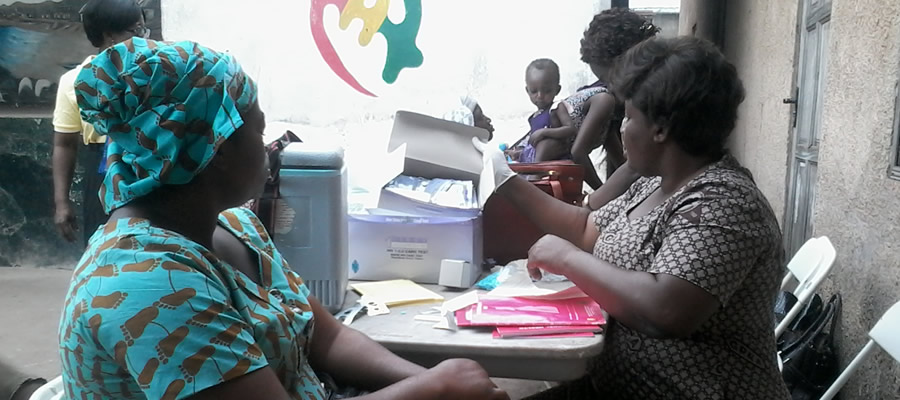

The District Health Management Team (DHMT) manages the health services in the District. The health of the population is basic necessity for its development. Consequently, a broader outlook of health delivery consider variables such as health facilities, adequacy of health personnel, top ten diseases and immunisation coverage.
Access to Health Facilities
Presently, there is no District hospital for Asutifi North. It is only Kenyasi and Gyedu which have health centres. Although there seems to be some health institutions in the other parts of the District, however these are inadequate. The other health facilities are located at Gambia (Rural Clinic), Biaso CHPS Compound and Goamu CHPS Compound. The whole District depends on only 2 doctors who are based at Kenyasi with 2 Physician Assistants, 39 Nurses and 45 Traditional Birth Attendants.
In terms of private health facilities, there is no hospital but a clinic at Kenyasi and an S.O.S Clinic for Newmont Ghana Gold at Ntotroso/Kenyasi. There are also Maternity Homes at Kenyasi and Kensere. The human resource strength of these private facilities is 1 doctor, 2 midwives and 5 nurses.
Nevertheless, infrastructural facilities in these health institutions are not all that encouraging thereby making health delivery very difficult. Tables 1.42 and 1.43 depict data on public and private health facilities.
Ten Top Causes of OPD Morbidity - 2013
The top ten causes of OPD morbidity accounted for 77 percent whilst other diseases represented 23 percent. Among the top ten causes, malaria was the highest representing 32 percent. Acute respiratory tract infection totaled 17 percent whiles skin diseases ulcers placed third with 7 percent. Table 1.43 gives analysis of top ten causes of OPD morbidity in 2013.
Tuberculosis
Based on a District’s population, some calculations are made to get the number of people expected to be suffering from tuberculosis. These are known as TB cases notified. In the year 2010 and 2011 no TB cases was notified. But in 2012, 21 cases were notified. In the year 2013, the target for TB cases was 62. Out of this number, only 19 cases were detected in the District. TB cases detected increased from 61 in 2012 to 62 in 2013. TB cases cured have been reducing from 12 in 2012 to 10 in 2013 based on the 50 targets of 2013. Table 1.44 shows cases of tuberculosis recorded from 2010-2013.
Reproductive Health
Concerning reproductive health, the total number of Ante-Natal Care (ANC) Registrants in 2010 were 2,295 as in table 1.45. Though in 2011 and 2012, there was an increase and decrease in terms of numbers, the percentage difference was rather diminishing. For instance, there was an increase of 18.9 percent of Ante –Natal Care (ANC) Registrants from 2295 in 2010 to 2450 in 2011 but in 2012 the increment accounted for 15.9 percent which is less. In 2013 however, out of the set target, 127 percent was achieved, it was 52.2 percent less as compared to the 2012 figure.
There is a possibility that as a result of the education on family planning, fewer women are giving birth. Another probability could be that pregnant women resort to other facilities. This situation needs to be investigated further. This analysis is the same for ANC registrants receiving IPTI (anti-malaria treatment). It presupposes that if the numbers of ANC registrants are reducing as the years go by, definitely there will be a reduction in the number taking the IPTI.
Immunisation Programme
As analysed in table 1.46, it goes to say that once there was a reduction in the number of ANC registrants, children immunised for BCG at birth would also automatically see a reduction in numbers over the years under review. From a figure of 2,292 in 2010, it jumped to 2,345 in 2011, children immunised for BCG reduced to 1,962 in 2012, and then again increased in 2013. In terms of other immunisation for children such as PENTA, OPV, Measles, Yellow Fever, PCV and ROTA2 there has been a steady increase from 2010 to 2013 as seen in table 1.46. This means parents have understood the need to immunise their children and the Ghana Health Service is also playing its part very well to get children in the District immunised at the various developmental stages of their life.
District Health Insurance Scheme
In order to have financial access to health care delivery system in the District, the District Health Insurance Scheme (DHIS) was introduced in order for all citizens in the District below the ages of eighteen (18) to sixty-five (65) years of old. Exemptions have been given to the aged, i.e. seventy (70) years by the Government. They therefore access health facilities without paying anything as their bills are borne by the Government.
The District Assembly has supported the District Insurance Scheme with logistics such as vehicle and office accommodation to run the offices. Ever since it was set up, the District Insurance Scheme has been able to register numerous clients in it catchment area. Sensitisation and mobilisation exercises on the scheme have been undertaken throughout the District courtesy District Information Service Department. The scheme has its own Board of Directors, Health Insurance General Assembly and Community Health Insurance Committee to help oversee the operations of day to day activities of the scheme.
Table 1.47 shows total membership of the scheme as of the year 2013. The total membership comprises that of Asutifi North and South Districts. For now, these two Districts operate the scheme because prior to the creation of Asutifi South District, the scheme was under the domain of Asutifi District. Total membership as at 2013 was 81,348. Out of this, 21,367 forms the informal sector representing 38 percent of the total membership, SSNIT contributors constitute 2,006 representing 0.02 percent. There are also categories of exempted persons; these are SSNIT pensioners, children under 18 years, pregnant women and aged from 70 years and over constitute about 63 percent of membership. Table 1.47 shows subscribers of National Insurance Scheme from 2011 to 2013.
Challenges of District Health Insurance Scheme
- There is lack of permanent office accommodation: Currently, the scheme is housed in one of the District’s old structure which does not befit the status of such a big scheme
- There is also lack of residential accommodation for the permanent staff
- Untimely release of insurance claims by the central Government
HIV and AIDS
HIV/AIDS control intervention is a major priority and is fully integrated into health services delivery in the District. This is in line with the priority and strategic interventions of the Ghana Health Service. Facilities providing Prevention of Mother to Child Transmission (PMTCT) services are:
1. Testing and counselling
2. Prevention of mother to child transmission
3. Anti-retro viral therapy (ART)
4. Support for People Living with HIV – food supplement for all clients attending weekly Anti-Retroviral Therapy Clinic
5. Health Education
Services are delivered in all the existing health facilities in the District.
Results of Services Provided
1. Prevention of Mother to Child Transmission (PMTCT)
a. # Pregnant women tested = 1,385
b. # Positive=12
c. Highest risk age group = 25-29 years
d. # On full treatment = 6
HIV & AIDS Testing and Counselling (HTC)
a. # Tested = 328
b. #Positive = 20
c. #Highest risk age group = 30-34 years
d. # On treatment = 20
Key Challenges
- Inadequate and crowded office accommodation for the ART clinic
- Irregular supply of program logistics i.e. HIV test Kits
- Inadequate trained counsellors in health facilities across the District
- Lack of financial support for District level activities i.e training, monitoring and supervision among others
Recommendations
- Training of counsellors in each health facility in the District
- Expansion of infrastructure for the existing ART clinic to accommodate the increasing number of clients at the clinic
- Financial support to the District Health Directorate to conduct monitoring and supervision in service provision sites
- Regular and adequate supply of test Kits to improve access to the program
Date Created : 11/15/2017 2:16:01 AM












 facebook
facebook
 twitter
twitter
 Youtube
Youtube
 +233 593 831 280
+233 593 831 280 0800 430 430
0800 430 430 GPS: GE-231-4383
GPS: GE-231-4383 info@ghanadistricts.com
info@ghanadistricts.com Box GP1044, Accra, Ghana
Box GP1044, Accra, Ghana